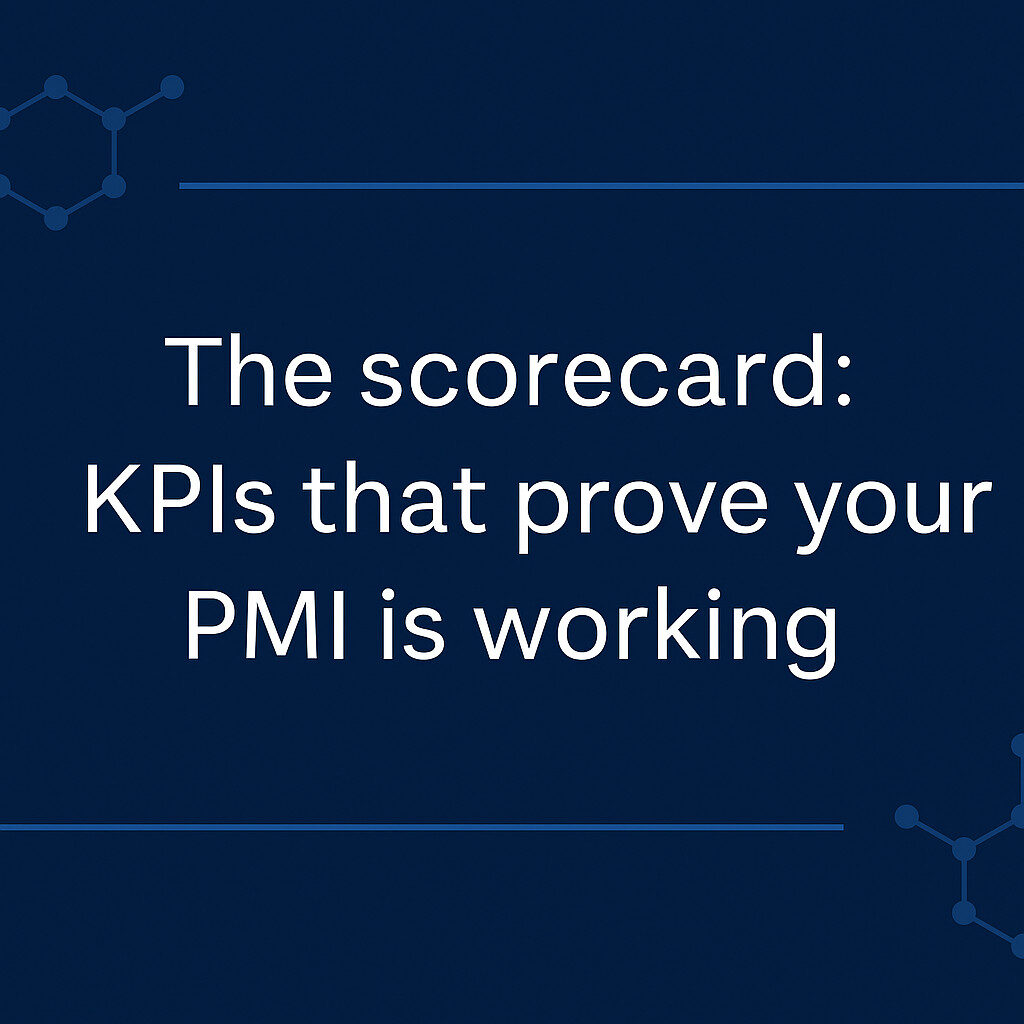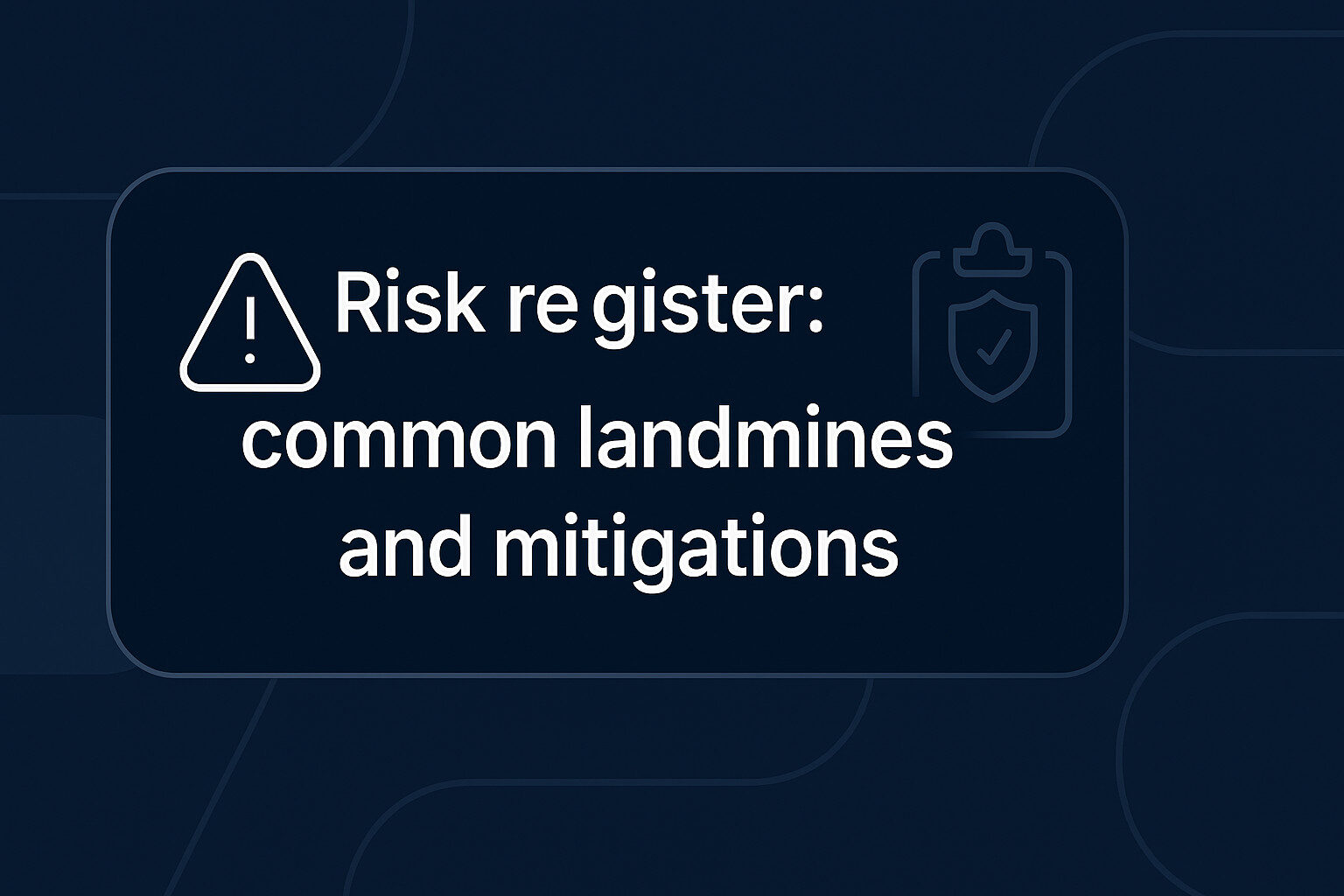When two organizations come together, success hinges on execution—not announcements. That’s doubly true for post-merger integration in polymers, where product quality, regulatory standards, and customer schedules leave little room for error. Whether your deal is platform + tuck-in or a full-scale merger of equals, the first 180 days decide whether you unlock synergies or bleed value through churn, downtime, and confused decision rights. This guide shows U.S. polymer manufacturers, compounders, and converters exactly which leadership roles to fill, how to sequence them, what “good” looks like, and how to measure progress week by week.

Why PMI in polymers is uniquely challenging (and worth doing right)
- Complex product/quality stack. Material science, compounding, and processing all influence yield, warranty, and compliance (ISO 9001/14001, IATF where applicable, USP Class VI/biocompatibility, UL/CSA, RoHS/REACH).
- Capex-heavy, asset-dense. Lines, tooling, utilities, and safety systems require harmonized standards and maintenance to avoid scrap and incidents.
- Channel complexity. Direct OEM/Tier, converters, and distributors coexist. Small mistakes in price architecture or territory rules cascade into channel conflict and margin leakage.
- Talent is the synergy. Synergy math often assumes throughput and mix improvements that only happen when the right leaders align people, process, and tech quickly.
Implication: The integration team must combine plant-first operators, quality and regulatory adults, and customer-facing commercial leaders who can defend price/mix during change.
The PMI north star: value creation without quality or safety tradeoffs
Your first job is to stabilize operations and protect customers while you harmonize systems, pricing, and the org model. In practice, that means:
- Zero missed shipments due to the merger.
- No compromises on EHS or product compliance.
- Transparent pricing and service rules; no surprises to distributors or OEMs.
- A realistic synergy calendar with owners, budgets, and milestones.
Everything below ladders to those outcomes.
Section 1 — The six critical leadership hires (and why)
Below are the roles most PMI programs in polymers need on day one. Some may be internal promotions; others must be brought in from the market. Keep titles short and outcomes sharper.
Role | Core mandate | Why now |
|---|---|---|
VP, Integration Management Office (IMO) | Own the master plan, synergy validation, cadence, risk & comms | Single throat to choke; prevents PMO drift |
VP/Director of Operations (Integration) | Stabilize plants, harmonize SOPs, drive throughput & cost | Avoids OEE loss, aligns maintenance & safety |
Head of Quality & Regulatory | Unify QMS, customer/regulatory commitments, audits | Prevents escapes & line stops at customers |
VP of Commercial Excellence | Price/mix governance, key account retention, distributor rules | Protects revenue & margin during change |
Head of Supply Chain & SIOP | One plan for demand, supply, inventory, logistics | Stops firefighting; aligns capex, labor, inventory |
Head of People & Culture (HRBP, PMI) | Org design, leader selection, retention, change management | Keeps A-players; reduces rumor & resistance |
1) VP, Integration Management Office (IMO)
Non-negotiables: cross-functional authority, financial literacy, manufacturing respect, risk management, and crisp communication.
Day-1 outputs: integration charter, RACI, decision rights, weekly/biweekly cadence, synergy ledger with baselines and owners.
2) VP/Director of Operations (Integration)
Non-negotiables: multi-site operations, TPM/RCM, OEE/SMED, utilities/capex, and a bias for Gemba.
Day-1 outputs: “stabilize the floor” plan, hold-the-line SOPs, common stop card, maintenance/critical spares review, and a red-flag list for utilities and safety.
3) Head of Quality & Regulatory
Non-negotiables: QMS leadership, APQP/PPAP where relevant, SPC/MSA, 8D, customer portals, and regulatory dossier management.
Day-1 outputs: unified change control, complaint/CAPA harmonization, customer audit calendar, and a “single source of truth” for specs and test methods.
4) VP of Commercial Excellence
Non-negotiables: price architecture, discount ladders, freight/surcharge logic, CRM hygiene, and key-account planning.
Day-1 outputs: moratorium on ad-hoc discounts, named owner for top 20 accounts, distributor rules, and a forecast quality uplift plan.
5) Head of Supply Chain & SIOP
Non-negotiables: S&OP/IBP, MRP parameterization, safety stock modeling, TMS/WMS leadership, supplier scorecards.
Day-1 outputs: one 13-week rolling plan, SKU rationalization criteria, slow-moving/obsolete (SLOB) playbook, and a logistics risk grid.
6) Head of People & Culture (PMI HRBP)
Non-negotiables: org design, leadership assessment, retention mechanics, communications, and labor law literacy.
Day-1 outputs: interim org chart, leader confirmations, flight-risk map, retention offers for A-players, and transparent comms.
Section 2 — The first 180 days, broken into sprints
Days 0–30: Stabilize, simplify, signal
Goals: keep customers, keep quality, keep people.
Leadership cadence: daily standups (week 1), then 3x/week; weekly steering with CFO/CEO.
Actions
- Plant stability: freeze non-critical changes; confirm critical spares; verify preventive maintenance backlog; publish “stop-the-line” rules.
- Quality: unify deviation/waiver process; one spec library; one complaint/CAPA queue; publish audit response plan.
- Commercial: message price policy and service SLAs; schedule top-20 account reviews; hold distributor webinars.
- Supply chain: merge demand signals; rationalize lead times and lot sizes; set inventory targets for A/B SKUs.
- People: identify A-players; issue retention packages; name interim leaders; start a rumor-control cadence (Q&A every Friday).
Deliverables (30-day)
- Integration master plan and RACI
- Harmonized QMS “minimums” and critical SOPs
- 13-week supply plan and inventory targets
- Top-20 account rescue plans
- Talent heatmap and retention actions
Days 31–90: Harmonize & execute early synergies
Goals: unlock low-risk synergies; demonstrate momentum; still zero quality shortcuts.
Actions
- Operations: cross-site SMED events; maintenance standardization (TPM pillars); utilities quick wins (compressed air, steam traps, lighting).
- Quality: align inspection/test methods; consolidate gages; launch SPC dashboards; close top 10 CAPAs.
- Commercial: deploy price architecture; centralize exception approvals; align freight/surcharge; roll out distributor health score.
- Supply chain: supplier re-bids; logistics lane optimization; Kanban/min-max on top movers; safety stock re-calibration.
- People: confirm final org; publish role charters; management training on coach-the-coach and change.
Deliverables (90-day)
- Validated synergy ledger (run-rate and one-offs)
- KPI boards at each site + weekly funnel/forecast dashboard
- Standard work packages (setup, changeover, inspection)
- Distributor agreements updated; channel conflict rules published
- Formalized org chart and compensation harmonization plan
Days 91–180: Scale, standardize, and prove value
Goals: institutionalize wins; attack medium-risk synergies; publish before/after metrics.
Actions
- Operations: automate high-ROI stations; OEE uplift roadmap; cross-train to reduce single points of failure; reliability analytics.
- Quality: rolled-throughput yield (RTY) measurement and projects; supplier quality escalation; customer scorecard improvements.
- Commercial: price/mix improvement projects; new-product launch harmonization; national account multi-year renewals.
- Supply chain: network redesign modeling; DC footprint optimization; packaging standardization; supplier development.
- People: succession plans; skill-based pay pilots; engagement survey with action plans.
Deliverables (180-day)
- Before/after KPI pack (plants, commercial, supply, people)
- Phase-2 synergy plan with capex & ROI
- Internal case studies (Gemba wins, price defense, service level gains)
Updated operating model document (“how we run the business”)

Section 3 — The scorecard: KPIs that prove your PMI is working
Keep tables tight with short entries.
Plant & quality
KPI | Target |
OEE | Flat → +5 pts by 180d |
First-pass yield | ↑ trend |
Scrap/rework | ↓ trend |
MTBF / MTTR | ↑ / ↓ trend |
Recordable incident rate | ≤ pre-deal |
Customer PPM / complaints | ↓ trend |
CAPA closure time | ≤ 30 days avg |
Supply chain & service
KPI | Target |
OTIF | ≥ 95% |
Inventory turns | ↑ vs. baseline |
SLOB | ↓ trend |
Supplier OTD | ≥ 95% |
Logistics cost / cwt | ↓ vs. baseline |
Commercial
KPI | Target |
Price/mix delta | Positive |
Discount exceptions | ↓ trend |
Forecast accuracy | ≥ 70% |
Distributor health score | ≥ target |
Top-20 account retention | 100% |
People
KPI | Target |
A-player retention | ≥ 95% |
Critical vacancy time | ≤ 45 days |
Training completion | ≥ 90% |
Engagement index | ↑ vs. 90-day |
Section 4 — How to hire the six roles fast (and right)
A. VP, Integration Management Office (IMO)
What to screen for
- Multi-site manufacturing integration experience
- Financial fluency (synergy math, cash/working capital)
- Authority and conflict management
- Clear, calm executive communication
Assessment (work-sample)
- 10-slide integration plan for a two-plant consolidation (risk, milestones, KPIs, costs).
- Simulate a steering meeting: defend scope, challenge sandbagging, resolve a conflict between Ops and Sales.
B. VP/Director of Operations (Integration)
What to screen for
- TPM/RCM, SMED, strong safety record, utilities optimization
- Running plants during change (greenfield, consolidation, or product transfers)
Assessment (work-sample)
- “Three plants, one plan” case: prioritize capex, labor, and CI events to unlock OEE and yield—without risking safety.
C. Head of Quality & Regulatory
What to screen for
- QMS leadership across two companies; customer audit wins; data-driven SPC/MSA
- Ability to say “no” when shortcuts risk escapes
Assessment (work-sample)
- Audit response exercise; rewrite a weak Control Plan; close a complaint with a crisp 8D.
D. VP of Commercial Excellence
What to screen for
- Price architecture, discount ladders, freight/surcharge logic; channel governance
- Forecast discipline and win/loss analysis
Assessment (work-sample)
- Price exception simulation; distributor QBR role-play; top-20 account retention plan.
E. Head of Supply Chain & SIOP
What to screen for
- S&OP/IBP, MRP tuning, inventory modeling; TMS/WMS
- Supplier development and risk mitigation
Assessment (work-sample)
- 13-week plan build; SLOB reduction play; logistics lane optimization with constraints.
F. Head of People & Culture (PMI)
What to screen for
- Org design, selection, retention programs, and change management
- Credibility with operators and executives
Assessment (work-sample)
- Talent heatmap; 180-day change plan; leadership communications pack.
Section 5 — Decision rights, RACI, and communications
Confusion is the enemy of speed. Publish a one-page decision rights matrix for the top 10 recurring decisions (pricing exceptions, product changes, supplier shifts, capex approvals, customer escalations). Example:
Decision | Owner | Consult | Inform |
Price exception > X% | Commercial Excellence | Finance, Sales Leader | CEO, IMO |
Process change on validated SKU | Head of Quality | Ops, R&D | Key Accounts |
Supplier change (critical) | Supply Chain | Quality, Ops | Commercial |
Communications rhythm
- Daily plant huddles (week 1); then site-level daily + weekly cross-functional.
- Weekly steering (CEO, CFO, IMO, Ops, Quality, Commercial, Supply, People).
Monthly All-Hands with progress, safety, customer shout-outs.

Section 6 — Risk register: common landmines and mitigations
Risk | Early indicator | Mitigation |
Spec confusion | Rising deviations/waivers | Single spec library; change control gate |
Quality escape | Customer alerts spike | CAPA triage; audit blitz; stop-ship criteria |
Channel conflict | Distributor complaints | Publish rules; joint QBRs; escalation path |
Price erosion | Discount exceptions ↑ | Tight approvals; value defense training |
Talent flight | A-players interviewing | Retention packages; career paths; manager check-ins |
Culture clash | “Us vs. them” chatter | One-team rituals; fair org design; transparent comms |
Section 7 — Budget the enablers (small line items, big impact)
- Integration playbook tooling: shared project tracker, synergy ledger.
- Quality digitization: SPC dashboards; eDMS for specs and CAPA.
- Price/quote governance: CPQ rules, exception workflow inside CRM/ERP.
- Training on the clock: safety refreshers; cross-site Kaizen.
- Recruiting SLAs: same-day decisions for high-impact roles; relocation support.
These investments pay for themselves through fewer delays, fewer errors, and faster synergy capture.
Section 8 — FAQ (add to your careers or investor page)
Q: Can we stretch internal leaders to cover these roles temporarily?
A: Yes—but not without capacity backfill. PMI is a full-time job; don’t sabotage plants by double-hatting without support.
Q: Do we need an external IMO lead?
A: Often. An external leader brings neutrality and speed; the rest of the team can be internal.
Q: How fast should we decide on the permanent org?
A: Within 60–90 days. Prolonged ambiguity kills retention and slows synergy capture.
Q: What if customers push for price cuts during integration?
A: Expect it. Arm your team with value stacks (quality, throughput, regulatory risk), ROI calculators, and clear exception rules.
Final word
M&A promises synergy, but only disciplined leadership delivers it. In polymers, the line between “great integration” and “costly mess” is thin: one bad spec change, one confused price letter, or one missed maintenance window can erase months of modeling. Hire the six roles that matter, set decision rights, run short sprints with visible wins, and measure what counts. Do that for 180 days, and you won’t just integrate—you’ll compound advantages across quality, cost, and customer trust.




